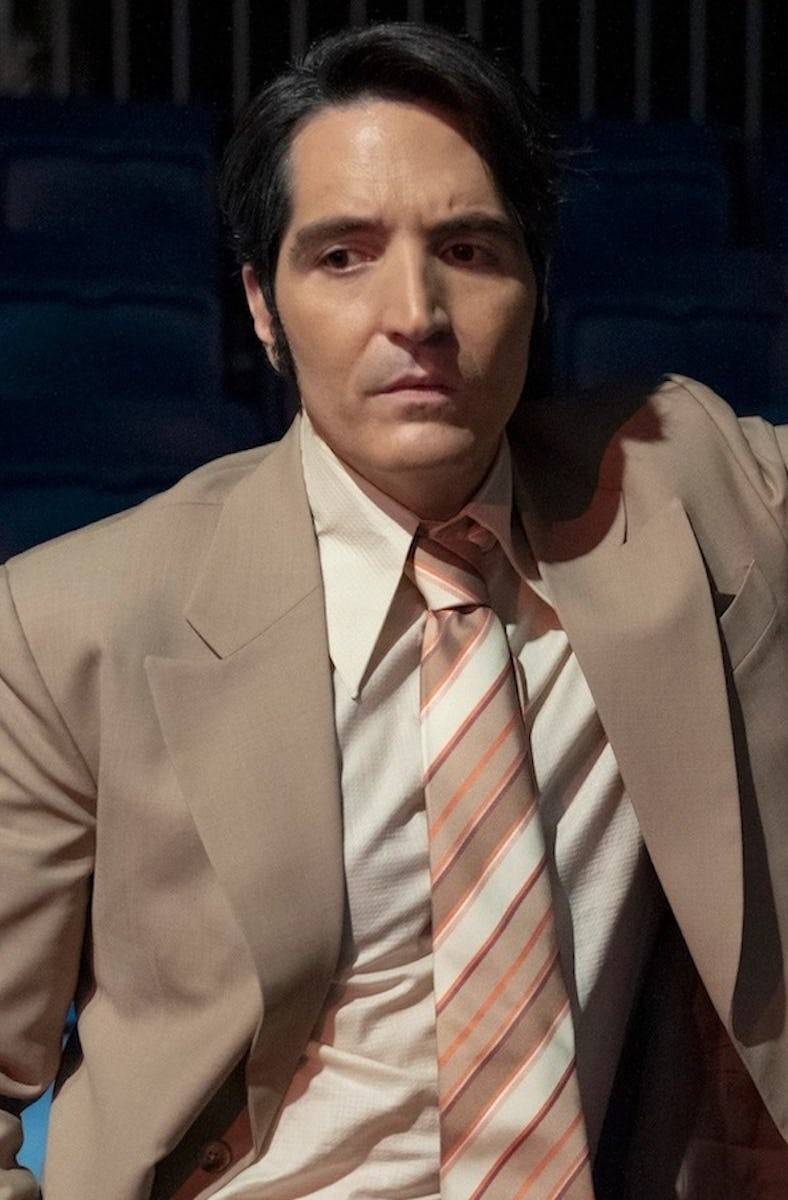Late Night with the Devil Injects New Life into Found-Footage Horror
The demonic horror movie is a brilliant new take on the mockumentary.

David Dastmalchian has been on a hot streak these last few years. Turns out that showing up in Marvel properties (Peyton Reed’s Ant-Man movies), a DC property (James Gunn’s The Suicide Squad), and a mega-sized adaptation of a genre-defining science fiction novel (Denis Villeneuve’s Dune) looks good on an actor’s resume. But there’s more to Dastmalchian than blockbuster roles. The actor has an indie weirdo streak running through films like Joel Potrykus’ Relaxer and Collin Schiffli’s Animals, which he also wrote.
Whether intentional or not, Australian brotherly filmmaking duo Colin and Cameron Cairnes have seized on Dastmalchian’s rapid profile expansion for their latest project, Late Night with the Devil. Veterans of low-budget horror-comedy filmmaking, the Cairnes match Dastmalchian’s rising star with that of their doomed hero, Jack Delroy, host of the syndicated small hours talk show “Night Owls.” He’s a man of high ambition, second only to the legend, Johnny Carson, in the ratings race — but second won’t do.
Late Night with the Devil is set on Halloween 1977, one year after terminal illness took Jack’s wife, Madeleine (Georgina Haig). He has big plans on All Hallow’s Eve, his first show since Madeleine’s death, but there’s a malevolent force lurking in the studio with bigger plans for Jack. One by one, he brings on his guests: Christou (Fayssal Bazzi), an ostentatious spirit medium; Carmichael Haig (Ian Bliss), an ex-magician turned professional skeptic; and, saving the best for last, parapsychologist June Ross-Mitchell (Laura Gordon) and her famous patient, Lilly (Ingrid Torelli), the lone survivor of a Satanic cult’s literal parting blaze of glory, because self-immolation is preferable to prison. (There’s a singer, too but bedlam erupts before she gets called to the stage. Lucky her.)
The movie hybridizes found footage and standard narrative techniques into a straightforward basic conceit: We’re watching the “master tape” of that fateful October broadcast, filmed before a live audience. Fittingly, the Cairnes approach the production as a period talk show, using long takes, incandescent lamps to light the space, fourth wall-breaking acknowledgment of the cameras, a house band, and even a late-night show sidekick, Gus (Rhys Auteri).
Gus is actually more a punching bag, often abashed by Jack’s japes about him; their dynamic colors Jack more as a Conan O’Brien than a Carson. That’s another common trait Jack shares with Coco: He’s insatiably status-oriented. The faux-news segment recapping the ups and downs in Jack’s personal and professional lives tells us as much. “Despite Jack’s relentless quest to be number one,” the voiceover says, “they are considered one of show business’ happiest and most enduring couples.” The ominous dots connect themselves. Jack is still mourning his wife; he’s back on TV on Halloween; his guests each have some degree of relation with the occult. That’s a powder keg prepped to blow.
David Dastmalchian delivers a jittery, terrifying performance in Late Night with the Devil.
The Cairnes oblige their explosives, though the fuse takes time to reach the barrel once they strike the match. Compared to the Cairnes’ prior features, 100 Bloody Acres and Scare Campaign, Late Night with the Devil is a change in pace; they’re playing a slow-burn game, reserving an escalation of gruesome madness for the final 30 minutes. But the film’s spooky atmosphere and signaling of inevitable devilry introduce tension the moment Jack emerges from backstage in a somber, triumphant return to the show. Credit for that goes to the Cairnes’ setup as much as Dastmalchian’s performance; Jack’s body language is off, and not because he has live-television jitters or lingering grief. It’s desperation, something harder to parse, and certainly nothing good.
Late Night with the Devil finds general inspiration in a bygone era of late-night TV history, spanning the 1960s to the 1980s. It’s driven more specifically by the Cairnes’ fondness for Don Lane, the American host of Australia’s Tonight Show surrogate, who, like Jack, was preoccupied by the supernatural. It’s a time capsule. We don’t want for choice in our late night hosts today; we don’t watch television the way “Night Owl’s” audiences watched television, either. But that’s key to their illusion: They need to lull the audience into forgetting they’re watching a movie, and believing they’re watching television.
A more of-the-moment sensibility informs the movie’s ideas about what costs men will pay for fame and celebrity, too. Jack has at least one skeleton hanging in his closet: His association with a secretive arcane enclave for dudes, based in a remote woodland camp presumably surrounded by “no girls allowed” signs, raises red flag. The tell isn’t so specific that Late Night with the Devil gives itself away, of course, but we know that, like so many men with Jack’s name recognition and influence, the sunny image he’s built for himself is curated to maximize his audience reception.
Dastmalchian plays to Jack’s easygoing likability, but occasionally belies his charisma with agitation disguised by unctuousness. His nerves are up. The show has to go off without a hitch. But what constitutes a “hitch” in Late Night with the Devil remains under the surface until, almost unceremoniously, all hell breaks loose to Jack’s terror and our delight: nauseating gore, demonic menace, and underworld hallucinations (which may not be hallucinations at all).
Imagine a segment from a V/H/S film, but judiciously extended to feature-length. That’s the sensation of watching Late Night with the Devil, a brilliant take on the mockumentary that meets the style’s brief without skimping on the good stuff. The Cairnes’ credentials are well-established. With this movie, they, like Dastmalchian, may well be on the road to a new career peak.